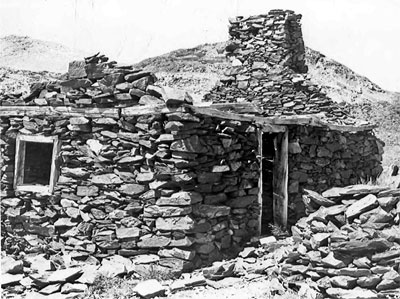National Register of Historic Places in Tuolumne County
Great Sierra Mine
AKA Dana Village
Tioga Pass
Yosemite National Park
Founded 1881
Mining activity on the crest and eastern slope of the central Sierra Nevada is closely interwoven with events leading to the formation of Yosemite National Park. The Great Sierra Mine was the site of the most intensive, albeit unprofitable, silver mining effort within the present park boundary. The surviving cabin is architecturally significant; its type of masonry construction is rare and exhibits a high level of handcraftsmanship.
In 1881 the Great Sierra Consolidated Silver Mining Company purchased all claims in the immediate vicinity of Tioga Hill. The company established the mountaintop community of Dana, including a post office branch, that same year, intending to work the mining operation year-round. Living conditions at and altitude of 11,000 feet were difficult and the miners soon relocated at Bennettville near the northern base of Tioga Hill.
Driving a tunnel into extremely hard rock required special drilling machinery. It took more than two months to haul eight tons of equipment the nine miles from the foot of Bloody Canyon to the Great Sierra Mine tunnel. The equipment was transported on six heavy sleds by ten to twelve men and two mules. One section required an almost vertical climb of 2,160 feet.
In 1884 the tunnel had been driven 1,784 feet and more than $300,000 expended when the Great Sierra Consolidated Silver Mining Company collapsed and closed down operations.
The claim changed hands several times and in 1933 work was resumed with modern equipment. The tunnel was driven several hundred feet further without striking the Sheepherder Lode and the second ill-fated operation ended. Today the National Park Service controls access to the mine tunnel.
The mining activity on Tioga Hill attracted hundreds of men and women to Yosemite's high Sierra region. Conservationists, already lobbying to establish a federal reserve that would abolish grazing in Tuolumne Meadows and the indiscriminate cutting of trees in the sugar pine tracts, agitated anew over the potential destruction of spectacular scenery caused by mining.
It is difficult to assess whether Tioga Hill and its environs would have been included in the boundaries delineating Yosemite National Park in 1890 if the Sheepherder Lode had proven to contain factual, instead of legendary, wealth.
Excerpted from the NRHP nomination dated 19 December 1977.
